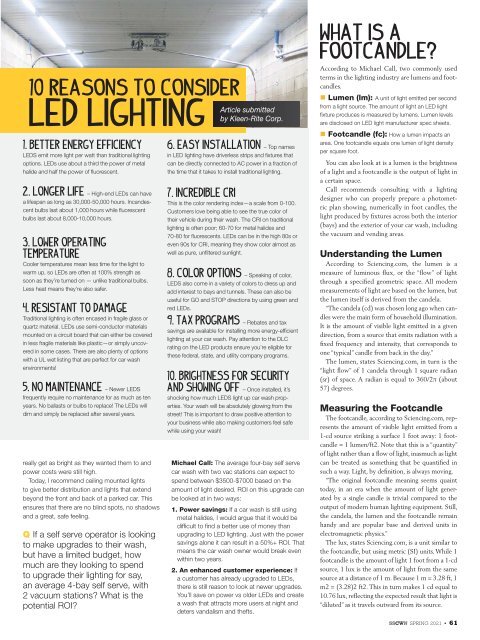Create successful ePaper yourself
Turn your PDF publications into a flip-book with our unique Google optimized e-Paper software.
10 REASONS TO CONSIDER<br />
LED LIGHTING<br />
1. BETTER ENERGY EFFICIENCY<br />
LEDS emit more light per watt than traditional lighting<br />
options. LEDs use about a third the power of metal<br />
halide and half the power of fluorescent.<br />
2. LONGER LIFE – High-end LEDs can have<br />
a lifespan as long as 30,000-50,000 hours. Incandescent<br />
bulbs last about 1,000 hours while fluorescent<br />
bulbs last about 8,000-10,000 hours.<br />
3. LOWER OPERATING<br />
TEMPERATURE<br />
Cooler temperatures mean less time for the light to<br />
warm up, so LEDs are often at 100% strength as<br />
soon as they’re turned on — unlike traditional bulbs.<br />
Less heat means they’re also safer.<br />
4. RESISTANT TO DAMAGE<br />
Traditional lighting is often encased in fragile glass or<br />
quartz material. LEDs use semi-conductor materials<br />
mounted on a circuit board that can either be covered<br />
in less fragile materials like plastic—or simply uncovered<br />
in some cases. There are also plenty of options<br />
with a UL wet listing that are perfect for car wash<br />
environments!<br />
5. NO MAINTENANCE – Newer LEDS<br />
frequently require no maintenance for as much as ten<br />
years. No ballasts or bulbs to replace! The LEDs will<br />
dim and simply be replaced after several years.<br />
really get as bright as they wanted them to and<br />
power costs were still high.<br />
Today, I recommend ceiling mounted lights<br />
to give better distribution and lights that extend<br />
beyond the front and back of a parked car. This<br />
ensures that there are no blind spots, no shadows<br />
and a great, safe feeling.<br />
Q If a self serve operator is looking<br />
to make upgrades to their wash,<br />
but have a limited budget, how<br />
much are they looking to spend<br />
to upgrade their lighting for say,<br />
an average 4-bay self serve, with<br />
2 vacuum stations? What is the<br />
potential ROI?<br />
Article submitted<br />
by Kleen-Rite Corp.<br />
6. EASY INSTALLATION – Top names<br />
in LED lighting have driverless strips and fixtures that<br />
can be directly connected to AC power in a fraction of<br />
the time that it takes to install traditional lighting.<br />
7. INCREDIBLE CRI<br />
This is the color rendering index—a scale from 0-100.<br />
Customers love being able to see the true color of<br />
their vehicle during their wash. The CRI on traditional<br />
lighting is often poor; 60-70 for metal halides and<br />
70-80 for fluorescents. LEDs can be in the high 80s or<br />
even 90s for CRI, meaning they show color almost as<br />
well as pure, unfiltered sunlight.<br />
8. COLOR OPTIONS – Speaking of color,<br />
LEDS also come in a variety of colors to dress up and<br />
add interest to bays and tunnels. These can also be<br />
useful for GO and STOP directions by using green and<br />
red LEDs.<br />
9. TAX PROGRAMS – Rebates and tax<br />
savings are available for installing more energy-efficient<br />
lighting at your car wash. Pay attention to the DLC<br />
rating on the LED products ensure you’re eligible for<br />
these federal, state, and utility company programs.<br />
10. BRIGHTNESS FOR SECURITY<br />
AND SHOWING OFF – Once installed, it’s<br />
shocking how much LEDS light up car wash properties.<br />
Your wash will be absolutely glowing from the<br />
street! This is important to draw positive attention to<br />
your business while also making customers feel safe<br />
while using your wash!<br />
Michael Call: The average four-bay self serve<br />
car wash with two vac stations can expect to<br />
spend between $3500-$7000 based on the<br />
amount of light desired. ROI on this upgrade can<br />
be looked at in two ways:<br />
1. Power savings: If a car wash is still using<br />
metal halides, I would argue that it would be<br />
difficult to find a better use of money than<br />
upgrading to LED lighting. Just with the power<br />
savings alone it can result in a 50%+ ROI. That<br />
means the car wash owner would break even<br />
within two years.<br />
2. An enhanced customer experience: If<br />
a customer has already upgraded to LEDs,<br />
there is still reason to look at newer upgrades.<br />
You’ll save on power vs older LEDs and create<br />
a wash that attracts more users at night and<br />
deters vandalism and thefts.<br />
WHAT IS A<br />
FOOTCANDLE?<br />
According to Michael Call, two commonly used<br />
terms in the lighting industry are lumens and footcandles.<br />
• Lumen (lm): A unit of light emitted per second<br />
from a light source. The amount of light an LED light<br />
fixture produces is measured by lumens. Lumen levels<br />
are disclosed on LED light manufacturer spec sheets.<br />
• Footcandle (fc): How a lumen impacts an<br />
area. One footcandle equals one lumen of light density<br />
per square foot.<br />
You can also look at is a lumen is the brightness<br />
of a light and a footcandle is the output of light in<br />
a certain space.<br />
Call recommends consulting with a lighting<br />
designer who can properly prepare a photometric<br />
plan showing, numerically in foot candles, the<br />
light produced by fixtures across both the interior<br />
(bays) and the exterior of your car wash, including<br />
the vacuum and vending areas.<br />
Understanding the Lumen<br />
According to Sciencing.com, the lumen is a<br />
measure of luminous flux, or the “flow” of light<br />
through a specified geometric space. All modern<br />
measurements of light are based on the lumen, but<br />
the lumen itself is derived from the candela.<br />
“The candela (cd) was chosen long ago when candles<br />
were the main form of household illumination.<br />
It is the amount of visible light emitted in a given<br />
direction, from a source that emits radiation with a<br />
fixed frequency and intensity, that corresponds to<br />
one “typical” candle from back in the day.”<br />
The lumen, states Sciencing.com, in turn is the<br />
“light flow” of 1 candela through 1 square radian<br />
(sr) of space. A radian is equal to 360/2π (about<br />
57) degrees.<br />
Measuring the Footcandle<br />
The footcandle, according to Sciencing.com, represents<br />
the amount of visible light emitted from a<br />
1-cd source striking a surface 1 foot away: 1 footcandle<br />
= 1 lumen/ft2. Note that this is a “quantity”<br />
of light rather than a flow of light, inasmuch as light<br />
can be treated as something that be quantified in<br />
such a way. Light, by definition, is always moving.<br />
“The original footcandle meaning seems quaint<br />
today, in an era when the amount of light generated<br />
by a single candle is trivial compared to the<br />
output of modern human lighting equipment. Still,<br />
the candela, the lumen and the footcandle remain<br />
handy and are popular base and derived units in<br />
electromagnetic physics.”<br />
The lux, states Sciencing.com, is a unit similar to<br />
the footcandle, but using metric (SI) units. While 1<br />
footcandle is the amount of light 1 foot from a 1-cd<br />
source, 1 lux is the amount of light from the same<br />
source at a distance of 1 m. Because 1 m = 3.28 ft, 1<br />
m2 = (3.28)2 ft2. This in turn makes 1 cd equal to<br />
10.76 lux, reflecting the expected result that light is<br />
“diluted” as it travels outward from its source.<br />
SPRING 2021 • 61

















